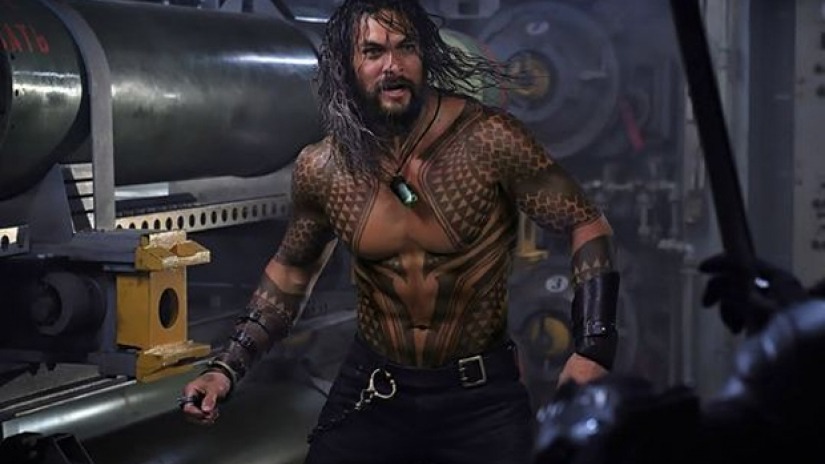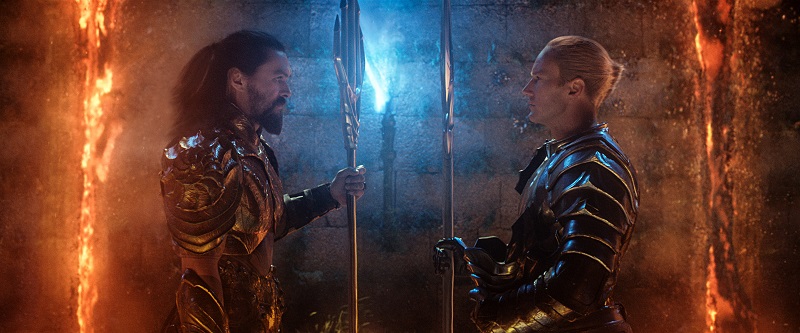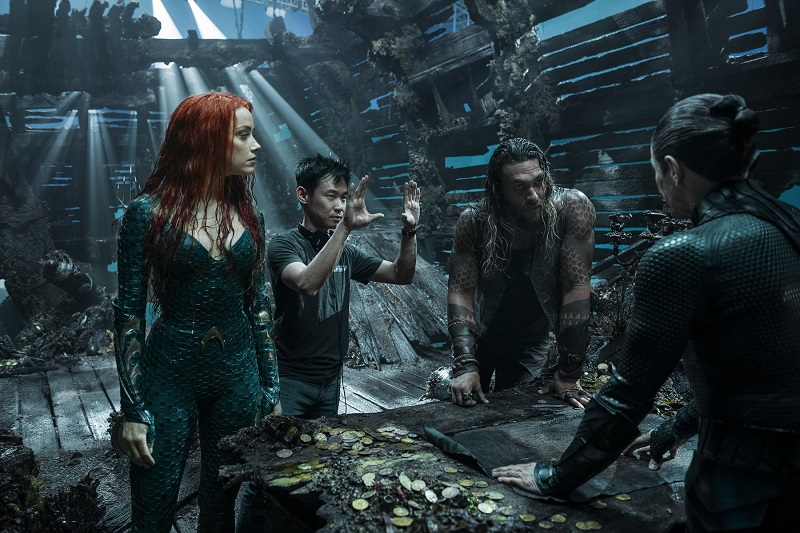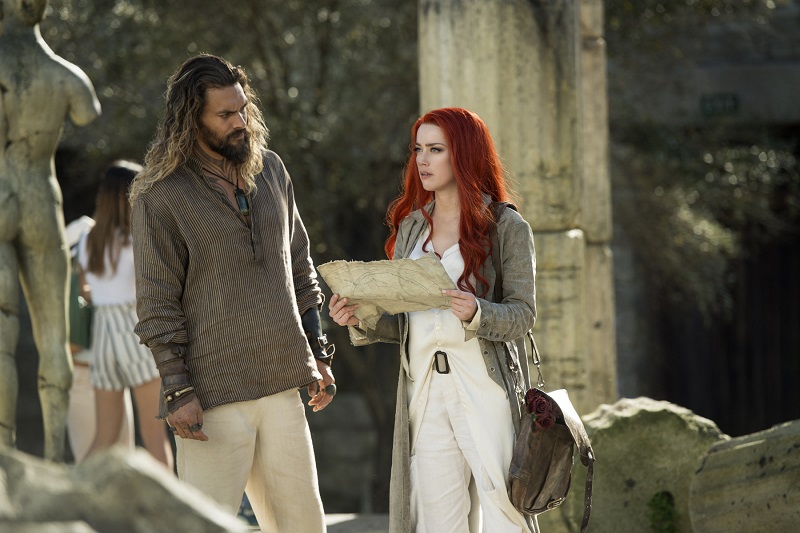Aquaman: How the King of Atlantis Got His Blockbuster Throne
After all these years, the Aquaman movie gives the King of Atlantis his moment.
Aquaman is a study in contradictions. The character has been around for nearly as long as his Justice League teammates, appearing in some of the most successful superhero cartoons and TV shows ever made. And yet, despite decades of stories that depict him as a warrior-king able to go toe-to-toe with some of the heaviest hitters in the DC Universe, the prevailing pop culture image of the character involves him jauntily riding a seahorse through the depths.
Warner Brothers’ upcoming Aquaman movie aims to change all that. The studio’s optimistic formula for success? An all-star cast led by a charismatic action star, a director who helmed the most acclaimed horror movie franchise of the modern era, and a devotion to worldbuilding not usually associated with superhero movies.
further reading: Aquaman Review
“A huge part of why I love this character is the fact that he’s an underdog,” says director James Wan. “He’s a punchline, a joke in the superhero world, and the irony is that I love that about him.”
Read the Den of Geek SDCC 2018 Special Edition Magazine Here!
There’s a reason Aquaman has endured for over 75 years. Comics luminaries like Jim Aparo, Kurt Busiek, Peter David, Geoff Johns, and Ivan Reis have told epic stories filled with palace intrigue and interpersonal drama, in settings that defy what you would ordinarily associate with traditional superhero stories. Aquaman’s tale isn’t as well known as those of Superman, Batman, or Wonder Woman, but it’s no less compelling.
Born of a human lighthouse keeper and the queen of a legendary underwater society, Arthur Curry is the rightful heir to the throne of Atlantis. His Atlantean half grants him tremendous strength and speed, both in the water and on land, and he can command all the creatures of the sea to do his bidding. As a superhero, he protects the world as a member of the Justice League. As King of Atlantis, he rules over a kingdom that encompasses two-thirds of the planet’s surface. And to think, all Batman has to do is keep the murder rate in Gotham City down and show up at a WayneTech board meeting every now and then.

It has been five years since 2013’s Man of Steel marked the official launch of what has come to be known (unofficially) as the DC Extended Universe. With Man of Steel came the promise of a Justice League movie, a shared superhero film universe, and the first indications that Aquaman was becoming a serious priority for the studio.
When he was cast as Aquaman, Jason Momoa was fresh off a star-making performance on Game of Thrones as Khal Drogo, leader of a barbarian-like tribe. His casting turned heads, as the most familiar Aquaman imagery depicts a clean-shaven, blond, blue-eyed monarch of the sea. But longtime comic book fans, and those familiar with the Justice League Unlimited animated series, also know Aquaman as a bare-chested, long-haired, harpoon-handed badass. It’s a vision of the character that may have also made an impression on Man of Steel and Justice League director Zack Snyder.
Momoa recalls his first discussions about a role in a DC movie. “[Zack Snyder] had been a fan of Game of Thrones and he obviously had the idea of me playing Aquaman, unbeknownst to me—I thought I was gonna play a villain to fight Superman and Batman—and he dropped the A-bomb on me,” Momoa says. “He explained that he wanted to cover me in tattoos, that the character was kind of like The Outlaw Josey Wales, he came from these two different worlds, he lived in the tides as a lone wolf who didn’t take shit from anyone, and wasn’t really a part of anything until he joins the Justice League. Then he harnesses his powers.”
Soon after Momoa’s casting was announced, director James Wan joined the project. Wan had a relationship with Warner Bros., having brought The Conjuring and its attendant sequels and spinoffs into the world, working with the studio to create the most successful horror shared cinematic universe in decades.
“I let it be known to [Warner Bros. CEO] Kevin Tsujihara that I’m a big fan of the comic book world and that they had a few properties that I would love to play with,” Wan says of how he came to be involved in a superhero movie.
It was while Wan was making Furious 7 for Universal Pictures that WB decided to make its move. “They reached out to me with a few DC properties,” Wan says. He decided on Aquaman. “I said, ‘If this is something that you guys are interested in, then I would be as well,’ and I told them, ‘This is how I see it. I love the idea of creating a visually unique world that we’ve never seen in a superhero movie before, and that’s where my interests would be.’”
Aquaman producer Peter Safran, who worked with Wan on both Conjuring films and the Annabelle spinoffs, agrees. “James was a bit of an underdog himself who succeeded massively,” he says, “[He] saw an opportunity to take Aquaman, who was the butt of every joke in the superhero community, and turn him into the ultimate badass.”

Momoa was able to use his own history to tap into Arthur’s conflicted nature. “I was raised in Iowa but I was born in Hawaii and spent my summers there,” he recalls. “Those are two different worlds. Not to say I was a king in either… It was just me and my mom a lot of the time, and I had a couple of buddies. But that’s something I could draw upon as an actor to use, kind of being an outcast.”
Momoa has a personal reason he wants to do Arthur justice on the big screen, too.
“It’s really cool to be a brown-skinned superhero of mixed race,” he says. “Just growing up that way, it’s kind of cool for kids who are like that; they can look up to that. It’s really special to be a Pacific Islander and represent that.”
Just as Aquaman is forever between two worlds, Momoa is similarly caught between the expectations of an audience that knows him primarily from Game of Thrones and the Arthur who will be brought to life on-screen come December.
“Nobody has ever let [Jason] play his charming, comedic side,” Safran says. “He’s always been the badass and, obviously, he plays that perfectly. But he’s also the most charming, funny guy who lights up a room when he comes into it. Instead of being a drinking-and-fighting badass, he’s a guy who has all those qualities but he’s also wry and self-aware, and he gets to play all of that in the movie. I think that that’s what makes it such a complete character.”
“I really wanted to bring out this roguish charm that he has in real life to the screen, and that’s not usually what directors ask of Jason,” Wan says of Momoa’s performance. “I honestly believe that when this film comes out people will not think of him just as a tough guy, but actually see him as a potential leading man or romantic lead in other genres. He’s got so many interesting sides to him.”
To do this, Arthur has to evolve from the character we were introduced to in Justice League. There, Arthur was a reluctant hero, one who performs relatively small-scale good deeds, like making sure an isolated fishing village has enough to eat in the frozen winter or saving fishermen in rough water – especially when there’s a bottle of whiskey waiting for him at the end of it. Despite Arthur’s initial reticence, Momoa brought a hint of exuberance to the role once the action started, giving the impression that Aquaman revelled in the chance to cut loose with his powers in a big fight against an alien army.
“We played him as the gruff hardass in Justice League,” Momoa says. “[In that movie], we don’t really know how he got to be that way, so I feel like now that we’ve done the solo movie, you really get to see where he came from, how his parents were treated and were separated, how he was raised, how he wasn’t accepted in Atlantis, how he wasn’t accepted on the land. I think you get a good vibe of what he was like, why he was the way he was in Justice League, and then you get to see him on his path to becoming the king and to believing in himself.”

Underwater action movies are nothing new in Hollywood, rare though they may be, but this is a profoundly different underwater epic than what we’ve seen in the past. Aquaman brings the legendary sunken kingdom of Atlantis and its remarkable inhabitants to life.
“There’s just no practicality to shooting humans underwater,” Safran says. “Atlanteans have to move with the same ease that we move with on land, and humans just can’t do that underwater so it’s almost always a situation where we shot dry.”
Designing an underwater world and its citizens in a dry environment is a unique challenge, and Wan and his team had to do some aquatic homework to get it right.
“I did a lot of underwater research,” Wan says. “We would shoot movement underwater and film it and study it. We would shoot costumes underwater and see how they would flow and move.”
Wan points out that most underwater movies—such as James Cameron’s The Abyss—deal with a human entering the alien environment of the ocean depths, rather than a character who is perfectly at home there. It’s natural to expect things to slow down when dealing with underwater photography, but when you’re dealing with Atlanteans, who have unique abilities, that isn’t the case.
“[Atlanteans] are incredible underwater, so nothing is slow motion,” Wan says. “If anything they move much faster when they’re surrounded by water as they’re designed for that environment. A lot of thinking went into how I wanted to design the movement, the look, the feel, and the aesthetic of that world, and how to get into the mindset of the characters [who live there].”
The abilities of the Atlanteans, coupled with the challenges of simulating superhuman life under the ocean, somehow kept Jason Momoa mostly dry. “I was constantly in a harness, flying around in front of a blue screen,” Momoa says. “We trained hard not to have to hold our breath!”
But special effects can only go so far, and the Aquaman team had to go to the source to make Atlantis and its people as believable as possible.
“I really had to break that ‘surface human’ type of thinking and understand that it’s a very different [visual] language that I have to design with my stunt team and working with my actors,” Wan says. “We looked at a lot of documentaries, we visited aquariums, and we studied aquatic life. We watched a lot of dolphins. If you look at the comics, when Atlanteans move underwater, they move just as fast and powerfully as Superman in some ways. We went into this knowing that this world is slightly hyper-real and heightened.”
“I don’t think that a movie like this could have been made even five years ago in this manner,” Safran says. “But thanks to the tremendous advances in technology and a combination of unbelievable stunt coordination and special effects people, we were able to put it together so it looks 100 percent real.”
As if the challenges of creating an underwater environment aren’t enough, there’s also all of the world building to consider. Atlantis, central to the Aquaman mythology, consists of seven kingdoms, each with their own unique look, feel, and history.
“The mythology and the story in this film really lent itself to world creation and that’s one of the things that I really wanted to do,” Wan says. “I wanted it to be a journey movie where we get to see the different flavors and worlds and cultures in the world of Aquaman.”
Fans will be pleased to know that one of those “different flavors” includes the Trench, a nightmarish undersea race, known to comic book readers as creatures who look like humanoid piranha.
“That was a fun one for me, because it really lent itself to my horror movie background and it allowed me to bring a slice of what I’m known for into this world,” Wan says of the Trench. “I really wanted to capture that the ocean is majestic and magical on the one hand but on the other hand it’s a terrifying experience.”

The movie itself is caught between two worlds, too. The DC superhero movies of the last five years have been met with mixed results, with only 2017’s Wonder Woman finding the elusive blockbuster alchemy of near-universal critical acclaim and box office success. Despite whatever baggage fans might expect from a shared cinematic universe, Aquaman is a standalone adventure, determined to tell its own tale.
“[Aquaman is] a different character in a very different movie than what might have been conceived of five years ago,” Safran says. “Part of that is due to the shift in the philosophy of where DC would like to be in terms of their movies, [which is to] maybe move away from the darkness and grimness of prior movies and into a world of more fun, colorful, and bright films. I feel like Aquaman is at least a continuation of the first step that Wonder Woman made.”
Whatever “shift in philosophy” that has gone on at the studio, the director seems unaffected. “I ultimately got to make the movie that I wanted to make,” says Wan. “I feel like I have had as much freedom to make this movie as any of my low-budget horror films. I had the freedom but I actually have the resources now to back up my vision.”
But Aquaman is still part of that shared universe. “[Aquaman] occurs after Justice League in terms of chronology, but it’s very much a standalone movie,” Safran says. “The studio gave us tremendous freedom to tell the story as James saw fit in terms of the look and feel.”
Safran and Wan both cite Raiders of the Lost Ark and Romancing the Stone as influences on Aquaman, two films that are known for a rollicking, high-adventure tone, with just the right touch of humor sprinkled throughout.
“It has all the great characters and action that you would expect in a superhero movie, but it has so much more,” Safran promises. “It has great humor, great family dynamics, and it’s about a great Shakespearean dramatic story.”
And make no mistake, there will be no shortage of action in the film. “Jon Valera was one of our fight coordinators and he had a whole fight choreography team that trained us in different styles of weapons,” Momoa says. “There’s a lot of wire work and there’s a lot of action. This is the first time I’ve ever had two stunt doubles, because one was constantly blocking out scenes while the other one was on set with me.”
Wan feels confident that he has done something that changes the usual expectations about a superhero movie. “I just wanted this to be an action-adventure film,” Wan says. “The sensibility of the look and where it takes place really lends itself to a classic high seas action-adventure storyline that embraces the romantic nature of the nautical themes and aesthetics. I really wanted to make a superhero movie that didn’t quite feel like a superhero movie.”
With any luck, the movie will show the general public what Aquaman fans have known for quite some time: The King of Atlantis deserves a blockbuster throne.
“Hopefully we’re just a little different,” Momoa says. “The cool thing is we get a journey underwater, which we haven’t really done in superhero movies, but the technology is there and we’re ready for it.”
